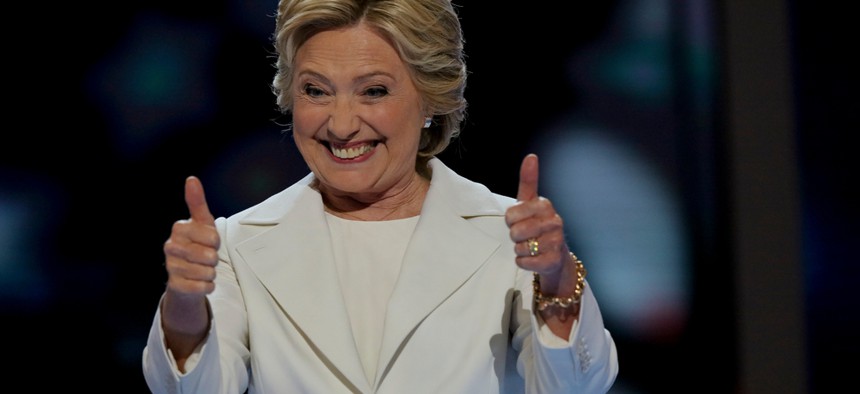New York boasts seven presidents, including the White House’s current occupant. But 2016 is not the only time the Empire State was home to a prominent also-ran. In honor of Presidents Day, here is a chronological guide to New York’s nearest non-presidents. They may not have won the White House, but they did win a place in this article.
Aaron Burr
He waited for it, but the time was never right for Burr. Burr was elected to the state Assembly from New York City in 1784, and was attorney general of New York from 1789 until 1791, and then became a U.S. senator from 1791 until 1797. He then returned to the assembly from 1798 until 1799. He finished in second in 1800, which at the time meant he became vice president from 1801 until 1805. Burr killed Alexander Hamilton in a duel in 1804, and was charged with treason in 1807 for an alleged conspiracy to conquer Mexico. After he was acquitted, he spent a period of self-imposed exile in Europe, and then returned to New York City, where he lived until his death in 1836.
Samuel Tilden
Tilden was the first – but not the last – presidential candidate from New York to win the popular vote but lose the election. Tilden served as an assemblyman and chairman of the state Democratic committee before becoming governor in 1875. In the extraordinarily convoluted election of 1876, confusion regarding Electoral College votes placed the matter in the hands of Congress. Congress created a 15-member election commission, which gave the presidency to Republican Rutherford B. Hayes in exchange for ending Reconstruction. Tilden soon retired from political life and lived out his remaining days as a recluse, like Hillary Clinton hiking in Chappaqua after the election of 2016. Tilden died in 1886.
Al Smith
Smith served as an assemblyman and on the New York City Board of Aldermen, the precursor to the New York City Council, before being elected governor for the first time in 1918. He lost his reelection bid in 1920, as gubernatorial terms were then two years, but was elected again in 1922, 1924 and 1926. Smith ran for president on the Democratic ticket in 1928, but strong anti-Catholic sentiment contributed to his election loss to Republican Herbert Hoover. He vied for the Democratic nomination again in 1932, but lost to his successor as governor, Franklin D. Roosevelt. Although his political ambitions were unfulfilled, Smith was a successful businessman. He was president of Empire State, Inc., which built and operated the Empire State Building.
Thomas Dewey
Dewey was a prominent lawyer in New York, with a career as a federal prosecutor, private lawyer and then Manhattan district attorney before he was elected governor of New York in 1942. Dewey ran for president three times, garnering the Republican nomination in 1944 in his race against Roosevelt, and then against his successor, Harry Truman, in 1948. Despite the infamous headline “Dewey Defeats Truman” published by the Chicago Tribune the day after the 1948 election, Dewey did not, in fact, defeat Truman. After his third term as governor ended in 1954, Dewey worked for a law firm in New York City, a descendant of which, Dewey & LeBoeuf LLP, still bears his name.
Nelson Rockefeller
As a scion of the prestigious New York family, Rockefeller could have had anything he wanted – except, apparently, the Republican nomination for president. While governor from 1959 until 1973, Rockefeller sought the nomination three times, in the 1960, 1964 and 1968 election. Widely considered the leader of the GOP’s moderate wing, he consistently lost to more conservative opponents. Rockefeller served as Gerald Ford’s vice president, but Ford, facing a right-wing primary challenge from Ronald Reagan, removed Rockefeller from the ticket. He was replaced with conservative Sen. Bob Dole of Kansas, and the “Rockefeller Republican” wing of the party was dealt its death blow.
Robert F. Kennedy
The former U.S. attorney general traded on his family name when he ran for Senate in New York in 1964, which was clearly a stepping stone for his presidential bid in 1968. Although a leading contender in the 1968 race for the Democratic nomination, he was assassinated before he could join the ranks of New Yorkers who became president.
Mario Cuomo
Although “Hamlet on the Hudson” never officially sought the Democratic nomination for president, he was widely considered to be a candidate in 1988 and in 1992, thanks in part to his exhilarating liberal call to arms at the 1984 Democratic National Convention. Both of those nominations went instead to other governors, Michael Dukakis of Massachusetts in 1988 and Bill Clinton in 1992. Meanwhile, Cuomo’s dithering left him a third-term governor vulnerable to defeat by George Pataki in 1994.
Hillary Clinton
As the most recent of New York presidential losers, the tale of Clinton’s political decline should be familiar. Like Robert F. Kennedy moving to New York with the goal of becoming senator and then president before her, Clinton ran for Senate as her husband’s second term as president was winding down. She served as New York’s junior senator from 2001 until 2009, when – after her first unsuccessful presidential bid – she was tapped by her former primary adversary, President Barack Obama to serve as Secretary of State. In 2016, she came tantalizingly close to becoming the first woman president, winning the popular vote but losing the Electoral College. While she was defeated by fellow New Yorker Donald Trump, she herself vanquished Brooklyn native Bernie Sanders in the Democratic primary, so at least she was not the least successful New York candidate.
NEXT STORY: Who's up and who's down?


